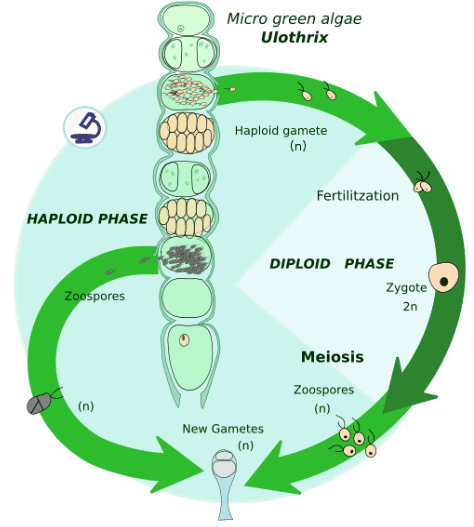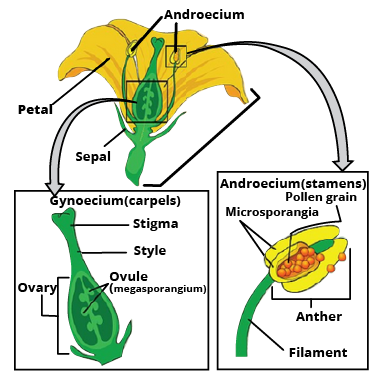CBSE Class 11 Biology Chapter-3 Important Questions - Free PDF Download
FAQs on Important Questions for CBSE Class 11 Biology Chapter 3 - Plant Kingdom
1. What are the most important topics to focus on in Chapter 3, Plant Kingdom, for the Class 11 Biology exam 2025-26?
For the CBSE Class 11 exam, you should focus on the following high-weightage topics from the Plant Kingdom chapter:
- The general characteristics and classification of Algae (Chlorophyceae, Phaeophyceae, Rhodophyceae) with examples.
- The reason why Bryophytes are called "amphibians of the plant kingdom".
- Life cycle patterns, especially the alternation of generations in Bryophytes and Pteridophytes.
- The concept and evolutionary significance of heterospory in Pteridophytes.
- Distinctive features of Gymnosperms, such as naked seeds, and their adaptations to extreme climates.
- Key differences between the major plant groups (e.g., Algae vs. Bryophytes, Gymnosperms vs. Angiosperms).
2. Why are Bryophytes called the ‘amphibians of the plant kingdom’?
Bryophytes are called the ‘amphibians of the plant kingdom’ because although they live on land (terrestrial habitats), they are critically dependent on water for sexual reproduction. The male gametes (antherozoids) are motile and require a film of water to swim to the archegonia (female sex organ) and fertilise the egg. This dual dependency on both land and water for completing their life cycle is analogous to amphibians.
3. Differentiate between Red Algae (Rhodophyceae) and Brown Algae (Phaeophyceae) based on their pigments and stored food.
The key differences between Red and Brown Algae are:
- Pigments: Brown Algae possess chlorophyll a, c, and fucoxanthin, which imparts their characteristic brown colour. In contrast, Red Algae contain chlorophyll a, d, and the red pigment phycoerythrin.
- Stored Food: Brown Algae store food as complex carbohydrates like mannitol and laminarin. Red Algae store food as Floridean starch, which is structurally very similar to amylopectin and glycogen.
4. What is heterospory, and why is it considered an important step in evolution?
Heterospory is the production of two distinct types of spores: small, male microspores and large, female megaspores. This is observed in Pteridophytes like Selaginella and Salvinia. It is considered a crucial evolutionary step because it is a precursor to the seed habit. This is because the development of the female gametophyte takes place while it is retained on the parent sporophyte, providing protection and nutrition to the developing embryo, a key requirement for seed formation.
5. How are the leaves of Gymnosperms adapted to withstand extreme environmental conditions?
Gymnosperm leaves, particularly in conifers, exhibit several xerophytic adaptations to minimise water loss and survive harsh climates. These include:
- Needle-like leaves that significantly reduce the surface area for transpiration.
- A thick cuticle on the leaf surface, which acts as a waterproof barrier.
- Sunken stomata (stomata located in pits) that reduce the rate of water loss by trapping a layer of moist air.
6. Explain the alternation of generations in a Bryophyte like moss.
The life cycle of a moss demonstrates a distinct alternation of generations between a dominant gametophyte (haploid, n) and a dependent sporophyte (diploid, 2n). The process is as follows:
- The main, photosynthetic plant body is the gametophyte (n), which produces gametes.
- Fertilisation of the egg by a motile antherozoid forms a diploid zygote (2n).
- The zygote develops into a sporophyte (2n), which remains attached to and is nutritionally dependent on the gametophyte.
- The sporophyte produces haploid spores (n) via meiosis.
- These spores germinate to form a new gametophyte, thus completing the cycle. This life cycle pattern is termed haplodiplontic.
7. What is the key difference between Gymnosperms and Angiosperms, even though both produce seeds?
The fundamental difference lies in how their seeds are borne. In Gymnosperms, the ovules are not enclosed by an ovary wall and remain exposed on the surface of megasporophylls. As a result, the seeds produced are "naked". In Angiosperms, the ovules are securely enclosed within an ovary. After fertilisation, this ovary develops into a fruit, and the ovules mature into seeds, which remain protected inside the fruit wall.
8. From an exam perspective, what are three important characteristics of Pteridophytes?
For a typical 3-mark question, three important characteristics of Pteridophytes are:
- They are the first terrestrial plants to possess vascular tissues (xylem and phloem), which is why they are also called 'vascular cryptogams'.
- The main plant body is a sporophyte (2n), which is well-differentiated into true roots, stems, and leaves.
- They show a clear alternation of generations where the gametophyte (called prothallus) is generally free-living and independent, though inconspicuous.
9. How does the gametophyte generation's role and independence change across Bryophytes, Pteridophytes, and Gymnosperms?
The status of the gametophyte shows a clear evolutionary trend of reduction:
- In Bryophytes, the gametophyte (n) is the dominant, photosynthetic, and independent phase of the life cycle. The sporophyte is dependent on it.
- In Pteridophytes, both the sporophyte (2n) and the gametophyte (n) are independent and free-living, but the sporophyte is the dominant, larger, and more complex phase.
- In Gymnosperms, the gametophyte is extremely reduced and is not free-living. It is entirely dependent on the parent sporophyte for its nutrition and protection.
10. What is the economic importance of Sphagnum moss?
Sphagnum, a type of moss, holds significant economic value for two main reasons:
- It provides peat, which is formed from the compression of partially decomposed Sphagnum over thousands of years. Peat is used as a fuel and a soil conditioner.
- Due to its remarkable water-holding capacity, it is used as packaging material for transporting live plants and flowers to prevent them from drying out.
11. What are gemmae and in which plant group are they found?
Gemmae are specialised structures for asexual reproduction, found primarily in liverworts, a class of Bryophytes (e.g., Marchantia). They are green, multicellular buds that develop in small receptacles called gemma cups on the parent thallus. When dispersed by rain, each gemma can grow into a new, genetically identical plant.
12. What makes the phenomenon of double fertilisation a unique and significant feature of Angiosperms?
Double fertilisation is a complex process found exclusively in Angiosperms. It involves two separate fusion events within the embryo sac:
- Syngamy: One male gamete fuses with the egg cell to create the diploid zygote (2n), which develops into the embryo.
- Triple Fusion: The second male gamete fuses with the diploid central cell (containing two polar nuclei) to form the triploid primary endosperm nucleus (3n).
This is significant because it leads to the formation of the endosperm, a nutritive tissue that feeds the developing embryo, making reproduction in Angiosperms highly efficient.



















